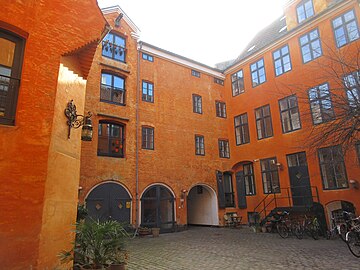
Ploug House is a listed Neoclassical property on the corner of Højbro Plads and Ved Stranden in central Copenhagen, Denmark. It dates from the building boom which followed after the Copenhagen Fire of 1795 but takes its name from the poet, publisher and politician Carl Ploug who lived there in the 1860s and 1870s and also published the newspaper Fædrelandet from the premises.

The Lehn House is a historic townhouse on Strandgade in the Christianshavn neighbourhood of central Copenhagen, Denmark. It is also known as the Tordenskjold House after Peter Jansen Wessel Tordenskiold commonly referred to as Tordenskjold, who for a while lived in the building. The Danish Authors' Society is now based in the property whose meeting facilities are also rented out for events. The rooms are notable for their lavish stucco ceilings and murals.
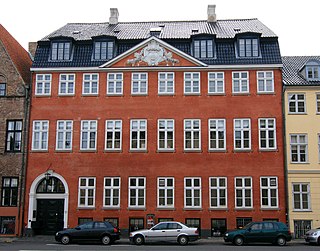
The Behagen House is a Neoclassical townhouse located at Strandgade 26 in the Christianshavn neighbourhood of Copenhagen, Denmark. The building was listed on the Danish registry of protected buildings and places in 1918.

The Strandgade 24 is a listed Neoclassical townhouse located on Strandgade in Copenhagen, Denmark.

The Cort Adeler House is a historic property located at Strandgade 22 in the Christianshavn neighbourhood of Copenhagen, Denmark. It takes its name from Admiral Cort Adeler who lived there for the last seven years of his life in the 17th century.

The Schottmann House Danish: is a historic property located at Strandgade 10 in the Christianshavn neighbourhood of Copenhagen, Denmark.

The Rhode House is a historic property located at the corner of Strandgade and Torvegade in the Christianshavn neighbourhood of central Copenhagen, Denmark.

The Jacob Holm House is a historic property located at Strandgade 4B in the Christianshavn neighbourhood of Copenhagen, Denmark. It was owned by the wealthy industrialist and shipowner Jacob Holm from 1819 to 1845. The building remained in the hands of the Holm family for more than 100 years. A plaque on the facade commemorates that N. F. S. Grundtvig was a tenant on the building.

Badstuestræde 18 is a Neoclassical property in Badstuestræde in the Old Town of Copenhagen, Denmark, constructed for brewer Peter Møller as part of the rebuilding of the city following the Copenhagen Fire of 1795. It was listed in the Danish registry of protected buildings and places in 1918. Notable former residents include the philologist Jacob Baden, actor Peter Jørgen Frydendahl, ballet master Carl Dahlén, actress and opera singer Johanna Elisabeth Dahlén and later ballet master of the Royal Swedish Ballet, Sigurd Harald Lund.
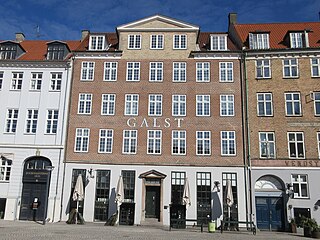
Gammel Strand 44 is a historic property overlooking Slotsholmens Kanal and Slotsholmen in the Old Town of Copenhagen, Denmark. The building was listed in the Danish registry of protected buildings and places in 1945. Notable former residents include ballet masters Antoine Bournonville and August Bournonville, physicist Hans Christian Ørsted and composer Friedrich Ludwig Æmilius Kunzen.

Nyhavn 19 is a property located at the corner of Nyhavn and Lille Strandstræde in central Copenhagen, Denmark. The building was listed on the Danish registry of protected buildings and places.

The Obel House is a Neoclassical property located at Vestergade 2 in the Latin Quarter of Copenhagen, Denmark. It was listed on the Danish registry of protected buildings and places in 1918.
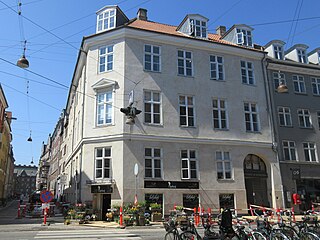
Rådhusstræde 6 is a Neoclassical property situated at the corner of Rådhusstræde and Kompagnistræde, betweenGammeltorv-Nytorv and Gammel Strand, in the Old Town of Copenhagen, Denmark. It was constructed by Andreas Hallander, one of the most active master builders in the rebuilding of the city following the Copenhagen Fire of 1795.The building was listed in the Danish registry of protected buildings and places in 1964. Notable former residents include the politicians Johan Nicolai Madvig and J.A. Hansen. Later acquired by the Danish Union of Teachers, it housed the Danish School Museum from 1995 to 2008.
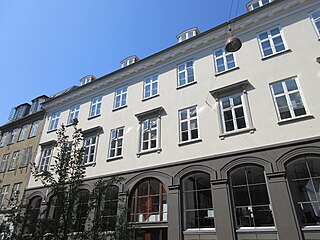
Skindergade 38/Dyrkøb 5 is a four-winged complex of 19th-century buildings with a nine-bays-long facade on Skindergade and a 10-bays-long facade on Dyrkøb, opposite the Church of Our Lady, in the Old Town of Copenhagen, Denmark. The two buildings fronting the streets were listed in the Danish registry of protected buildings and places in 1951. The two side wings—which attach them to each other along each their side of a central courtyard—are not part of the heritage listing. From October 1852 until his death three years later, Søren Kierkegaard was a lodger in the apartment on the first floor. Other notable former residents include the politicians Janus Lauritz Andreas Kolderup-Rosenvinge, Orla Lehmann and Valdemar Rudolph von Raasløff.

Strandgade 30 is one of the oldest townhouses situated on Strandgade in the Christianshavn district of central Copenhagen, Denmark. The three-winged building from 1635 is via an adjoining lower building from the 20th century and a three-storey warehouse connected to a two-storey building at Wildersgade 43 on the other side of the block. The property was from 1680 until at least the 1860s owned by brewers whose brewery was located in the yard. The painter Wilhelm Hammershøi resided in the apartment on the first floor from 1899 to 1909. Some 60 of the 142 paintings from this period of his life, including some of his most iconic works, are interior paintings from the apartment. Other notable former residents include the ship-owner, merchant and slave trader Jens Lind. A doorway in a brick wall connects the narrow, central courtyard to that of Strandgade 28. Strandgade 30 and Strandgade 28 were owned by the same owners from 1910. They were jointly listed in the Danish registry of protected buildings and places in 1918. The building at Wildersgade 43 and the adjacent warehouse in the courtyard are also part of the heritage listing.

The Sigvert Grubbe House is a Renaissance style townhouse situated at Strandgade 28 in the Chrstianshavn neighborhood of central Copenhagen, Denmark. The property comprises the building at Wildersgade 41 on the other side of the block as well as a half-timbered building separating two central courtyards from each other. The apartment on the first floor features a number of murals attributed to Nicolai Abildgaard. The entire complex was listed in the Danish registry of protected buildings and places in 1918. It takes its name after its first owner, Sigbert Grubbe, a favourite of ChristianIV. It was later owned by Jacob Benjamin Italiaender, a Sphardi Jew, who established a tobacco manufactory as well as a private sunagogue in the yard. The painter Peder Severin Krøyer grew up in the building in the 1860s.
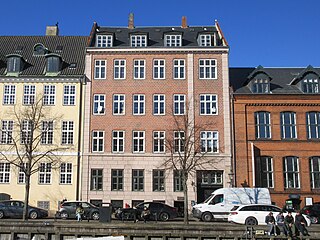
Overgaden Neden Vamdet 15 is a mid-19th-century property overlooking the Christianshavn Canal in the Christianshavn neighborhood of central Copenhagen, Denmark. It consists of an L-shaped building with high-end apartments from 1858 fronting the street and an older rear wing now used as office space, ateliers and storage space. The two buildings were both listed in the Danish registry of protected buildings and places in 1980. Notable former residents include the businessman Peter Heering and the author Henrik Pontopidan.

Nyhavn 53, also known as Madame Tofte's House, is a residential building overlooking the Nyhavn canal in central Copenhagen, Denmark. It was constructed with three storeys in the 1750s but owes its current appearance to a renovation in the 1870s. It was listed in the Danish registry of protected buildings and places in 1932. Notable former residents include the composer Peter Arnold Heise and the ballet dancer Augusta Nielsen. The Adventurers' Club of Denmark is based in a half-timbered warehouse in the courtyard.

Nyhavn 21/Lille Strandstræde 4, formerly known as Hotel L'ven, Hotel Kronprinsen and Fredsfondens Hus, is a complex of historic buildings overlooking the Nyhavn canal in central Copenhagen, Denmark. It consists of a late 17th-century building in Nyhavn and a just two bays wide building in Lille Strandstræde as well as a two-storey rear wing from 1748. It was listed in the Danish registry of protected buildings and places in 1945. The restaurant Cap Horn was a popular jazz venue in the 1950s. It is now part of the Tholstrup restaurant group. Notable former residents include the politician Jens Christian Christensen and painters Anna and Michael Ancher.
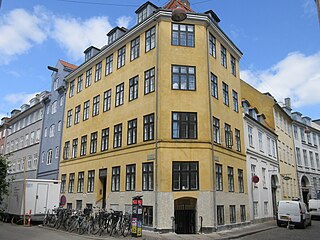
Knabrostræde 25 is an 1830s apartment building situated at the slightly acute-angled corner of Knabrostræde and Snaregade, close to Gammel Strand, in the Old Town of Copenhagen,, Denmark. It was listed in the Danish registry of protected buildings and places in 1945.






